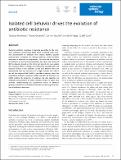| dc.contributor.author | Artemova, Tatiana | |
| dc.contributor.author | Gerardin, Ylaine | |
| dc.contributor.author | Dudley, Carmel | |
| dc.contributor.author | Vega, Nic | |
| dc.contributor.author | Gore, Jeff | |
| dc.date.accessioned | 2015-09-11T16:44:45Z | |
| dc.date.available | 2015-09-11T16:44:45Z | |
| dc.date.issued | 2015-07 | |
| dc.identifier.issn | 1744-4292 | |
| dc.identifier.uri | http://hdl.handle.net/1721.1/98465 | |
| dc.description.abstract | Bacterial antibiotic resistance is typically quantified by the minimum inhibitory concentration (MIC), which is defined as the minimal concentration of antibiotic that inhibits bacterial growth starting from a standard cell density. However, when antibiotic resistance is mediated by degradation, the collective inactivation of antibiotic by the bacterial population can cause the measured MIC to depend strongly on the initial cell density. In cases where this inoculum effect is strong, the relationship between MIC and bacterial fitness in the antibiotic is not well defined. Here, we demonstrate that the resistance of a single, isolated cell—which we call the single‐cell MIC (scMIC)—provides a superior metric for quantifying antibiotic resistance. Unlike the MIC, we find that the scMIC predicts the direction of selection and also specifies the antibiotic concentration at which selection begins to favor new mutants. Understanding the cooperative nature of bacterial growth in antibiotics is therefore essential in predicting the evolution of antibiotic resistance. | en_US |
| dc.description.sponsorship | National Institutes of Health (U.S.) (R01GM102311-01) | en_US |
| dc.description.sponsorship | National Institutes of Health (U.S.) (R00 Pathways to Independence GM085279-02) | en_US |
| dc.description.sponsorship | National Science Foundation (U.S.) (CAREER PHY-1055154) | en_US |
| dc.description.sponsorship | Alfred P. Sloan Foundation (Fellowship BR2011-066) | en_US |
| dc.description.sponsorship | Paul Allen Foundation (Distinguished Investigator Program) | en_US |
| dc.description.sponsorship | National Institutes of Health (U.S.) (New Innovator DP2) | en_US |
| dc.description.sponsorship | Pew Charitable Trusts (Pew Scholars Program in Biomedical Sciences 2010-000224-007) | en_US |
| dc.language.iso | en_US | |
| dc.publisher | Nature Publishing Group | en_US |
| dc.relation.isversionof | http://dx.doi.org/10.15252/msb.20145888 | en_US |
| dc.rights | Creative Commons Attribution | en_US |
| dc.rights.uri | http://creativecommons.org/licenses/by/4.0/ | en_US |
| dc.source | Nature Publishing Group | en_US |
| dc.title | Isolated cell behavior drives the evolution of antibiotic resistance | en_US |
| dc.type | Article | en_US |
| dc.identifier.citation | Artemova, T., Y. Gerardin, C. Dudley, N. M. Vega, and J. Gore. “Isolated Cell Behavior Drives the Evolution of Antibiotic Resistance.” Molecular Systems Biology 11, no. 7 (July 1, 2015): 822–822. | en_US |
| dc.contributor.department | Massachusetts Institute of Technology. Department of Physics | en_US |
| dc.contributor.mitauthor | Artemova, Tatiana | en_US |
| dc.contributor.mitauthor | Dudley, Carmel | en_US |
| dc.contributor.mitauthor | Vega, Nic | en_US |
| dc.contributor.mitauthor | Gore, Jeff | en_US |
| dc.relation.journal | Molecular Systems Biology | en_US |
| dc.eprint.version | Final published version | en_US |
| dc.type.uri | http://purl.org/eprint/type/JournalArticle | en_US |
| eprint.status | http://purl.org/eprint/status/PeerReviewed | en_US |
| dspace.orderedauthors | Artemova, T.; Gerardin, Y.; Dudley, C.; Vega, N. M.; Gore, J. | en_US |
| dc.identifier.orcid | https://orcid.org/0000-0003-4583-8555 | |
| dc.identifier.orcid | https://orcid.org/0000-0001-5532-2822 | |
| dc.identifier.orcid | https://orcid.org/0000-0002-9929-6109 | |
| mit.license | PUBLISHER_CC | en_US |
| mit.metadata.status | Complete | |
